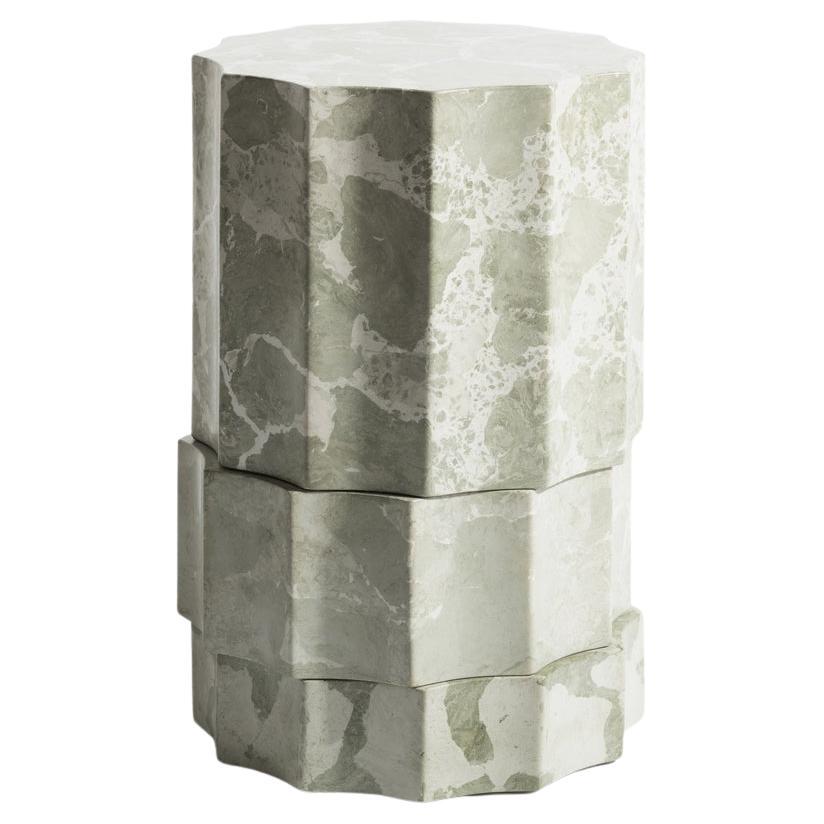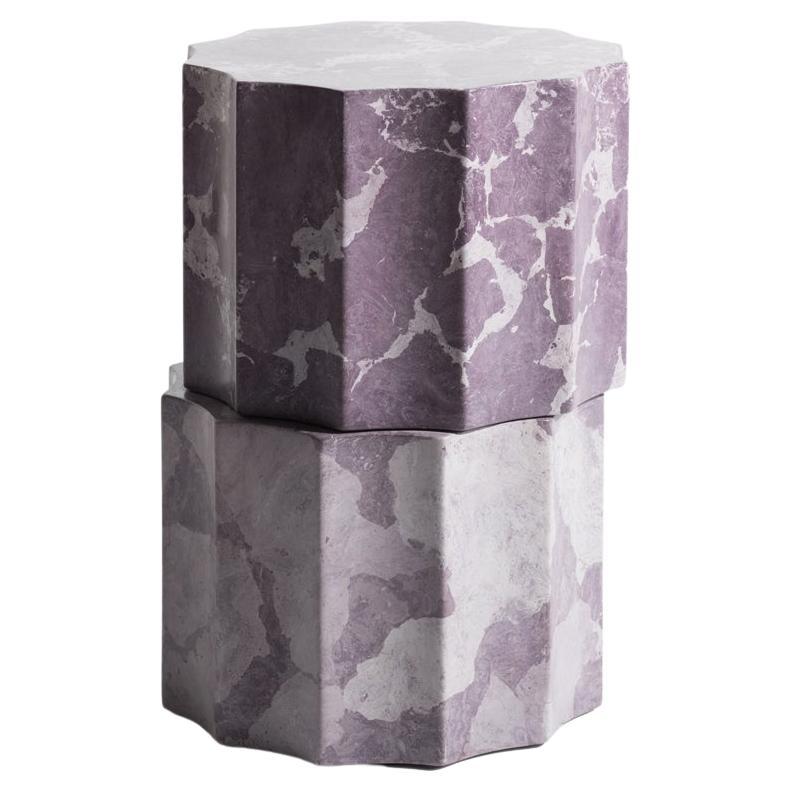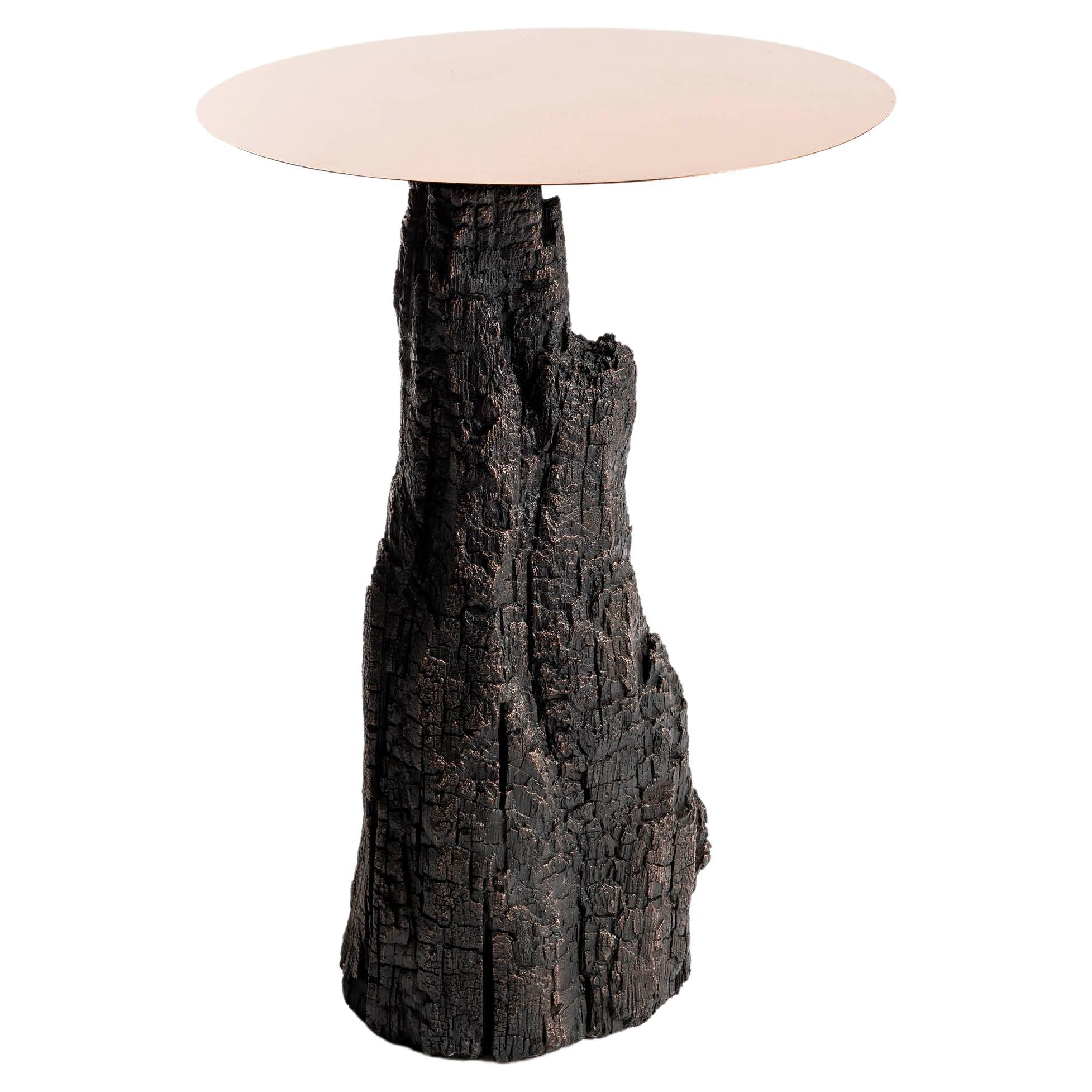Items Similar to Domus Pompeii Dioscuri Stool by Roberto Sironi
Want more images or videos?
Request additional images or videos from the seller
1 of 8
Domus Pompeii Dioscuri Stool by Roberto Sironi
About the Item
Rediscovered in 1748, after being buried for almost two millennia under a blanket of lava and ash following the eruption of Vesuvius, Pompeii redefines our relationship with the past
through its generative potential between reality and imagination.
Defined by Goethe “An incredible place, worthy of peaceful thoughts”, Pompeii has the power to transform inanimate archaeological material into narrative matter, merging past and present in a relationship of reciprocity and interaction.
Exploring the site, today as then, it is possible to admire the interiors decorated with frescoes that reproduce architectural partitions or that tell stories of myths and divinities, in rooms set up with marble elements that the owner used to display his most precious objects.
The Pompeian frescoes were made according to different techniques with colors obtained from earth and minerals such as cinnabar (Pompeian red), ochres (Pompeian yellow), by oxidation processes of metals as in the case of cerulean or by the pulverization of roots and animal bones as in case of greens and blacks.
DOMUS POMPEII is a capsule collection of five side tables made in Marmo di Rima, designed in dialogue with the architecture and chromatic-decorative techniques of Pompeii.
Marmo di Rima is a decorative technique created in Italy in the second half of the 19th century to simulate natural marble through a mixture (stucco) made with alabaster gypsum, water and mineral pigments. A technique in dialogue with that used by the decorators of the time, as Vitruvius describes in his VII book De Architectura, identifying the four different Pompeian styles: Primo Stile was developed through the simulation of architectural elements made of stucco with pigments diluted in water.
The project develops on the theme of the fluted column - one of the characterizing elements of Pompeian architecture - which is broken down and added together in a post-archaeological act in which the applied technique - Marmo di Rima - simulates the marbles used in the interiors of Pompeian Villas, where numerous varieties of marble from North Africa, the Greek Islands and Turkey have been found.
DOMUS POMPEII is designed around the concept of archaeological matter, where architectural, pictorial and material elements of archaeological matrix blend together with the aim of giving shape to the present in an infinite dialogue with the past. The colors, techniques, architectural materials of the Roman Pompeii are reworked and reinterpreted in a metamorphic process that results in the production of imagined archaeological artifacts.
- Creator:Roberto Sironi (Designer)
- Dimensions:Height: 19.69 in (50 cm)Width: 13.39 in (34 cm)Depth: 13 in (33 cm)
- Materials and Techniques:
- Period:
- Date of Manufacture:2022
- Production Type:New & Custom(Limited Edition)
- Estimated Production Time:Available Now
- Condition:
- Seller Location:Pireaus-Athens, GR
- Reference Number:1stDibs: LU1571229435892
Marmo di Rima
About the Seller
No Reviews Yet
Recognized Seller
These prestigious sellers are industry leaders and represent the highest echelon for item quality and design.
Established in 2011
1stDibs seller since 2015
17 sales on 1stDibs
- ShippingRetrieving quote...Ships From: Athens, Greece
- Return PolicyThis item cannot be returned.
More From This SellerView All
- Domus Pompeii Vettii Stool by Roberto SironiBy Roberto SironiLocated in Pireaus-Athens, GreeceRediscovered in 1748, after being buried for almost two millennia under a blanket of lava and ash following the eruption of Vesuvius, Pompeii redefines our relationship with the past through its generative potential between reality and imagination. Defined by Goethe “An incredible place, worthy of peaceful thoughts”, Pompeii has the power to transform inanimate archaeological material into narrative matter, merging past and present in a relationship of reciprocity and interaction. Exploring the site, today as then, it is possible to admire the interiors decorated with frescoes that reproduce architectural partitions or that tell stories of myths and divinities, in rooms set up with marble elements that the owner used to display his most precious objects. The Pompeian frescoes were made according to different techniques with colors obtained from earth and minerals such as cinnabar (Pompeian red), ochres (Pompeian yellow), by oxidation processes of metals as in the case of cerulean or by the pulverization of roots and animal bones as in case of greens and blacks. DOMUS POMPEII is a capsule collection of five side...Category
2010s Stools
MaterialsMarble
- Domus Pompeii Fauno Stool by Roberto SironiBy Roberto SironiLocated in Pireaus-Athens, GreeceRediscovered in 1748, after being buried for almost two millennia under a blanket of lava and ash following the eruption of Vesuvius, Pompeii redefines our relationship with the past through its generative potential between reality and imagination. Defined by Goethe “An incredible place, worthy of peaceful thoughts”, Pompeii has the power to transform inanimate archaeological material into narrative matter, merging past and present in a relationship of reciprocity and interaction. Exploring the site, today as then, it is possible to admire the interiors decorated with frescoes that reproduce architectural partitions or that tell stories of myths and divinities, in rooms set up with marble elements that the owner used to display his most precious objects. The Pompeian frescoes were made according to different techniques with colors obtained from earth and minerals such as cinnabar (Pompeian red), ochres (Pompeian yellow), by oxidation processes of metals as in the case of cerulean or by the pulverization of roots and animal bones as in case of greens and blacks. DOMUS POMPEII is a capsule collection of five side...Category
2010s Side Tables
MaterialsMarble
- Domus Pompeii Menandro Stool by Roberto SironiBy Roberto SironiLocated in Pireaus-Athens, GreeceRediscovered in 1748, after being buried for almost two millennia under a blanket of lava and ash following the eruption of Vesuvius, Pompeii redefines our relationship with the past through its generative potential between reality and imagination. Defined by Goethe “An incredible place, worthy of peaceful thoughts”, Pompeii has the power to transform inanimate archaeological material into narrative matter, merging past and present in a relationship of reciprocity and interaction. Exploring the site, today as then, it is possible to admire the interiors decorated with frescoes that reproduce architectural partitions or that tell stories of myths and divinities, in rooms set up with marble elements that the owner used to display his most precious objects. The Pompeian frescoes were made according to different techniques with colors obtained from earth and minerals such as cinnabar (Pompeian red), ochres (Pompeian yellow), by oxidation processes of metals as in the case of cerulean or by the pulverization of roots and animal bones as in case of greens and blacks. DOMUS POMPEII is a capsule collection of five side...Category
2010s Side Tables
MaterialsMarble
- Domus Pompeii Efebo Stool by Roberto SironiBy Roberto SironiLocated in Pireaus-Athens, GreeceRediscovered in 1748, after being buried for almost two millennia under a blanket of lava and ash following the eruption of Vesuvius, Pompeii redefines our relationship with the past through its generative potential between reality and imagination. Defined by Goethe “An incredible place, worthy of peaceful thoughts”, Pompeii has the power to transform inanimate archaeological material into narrative matter, merging past and present in a relationship of reciprocity and interaction. Exploring the site, today as then, it is possible to admire the interiors decorated with frescoes that reproduce architectural partitions or that tell stories of myths and divinities, in rooms set up with marble elements that the owner used to display his most precious objects. The Pompeian frescoes were made according to different techniques with colors obtained from earth and minerals such as cinnabar (Pompeian red), ochres (Pompeian yellow), by oxidation processes of metals as in the case of cerulean or by the pulverization of roots and animal bones as in case of greens and blacks. DOMUS POMPEII is a capsule collection of five side...Category
2010s Side Tables
MaterialsMarble
- Aphanès Side Table by Roberto SironiBy Roberto SironiLocated in Pireaus-Athens, GreeceCustom works and dimensions upon request.Category
2010s Side Tables
MaterialsMarble
- Fuoco Side Table in Bronze by Roberto SironiBy Roberto SironiLocated in Pireaus-Athens, GreeceRoberto Sironi has sought out the remains of trees that have been burned by fire, trunks hit by lightning, charred branches salvaged from the mountains. With the ancient technique of...Category
2010s Italian Side Tables
MaterialsBronze
You May Also Like
- Ausgebrannt Stools by Kaspar HamacherBy Kaspar HamacherLocated in San Francisco, CAA collection of stools formed by the hollowing out of oak tree trunks using fire. The oak comes from naturally fallen trees and all are made by the German artist Kaspar Hamacher. Hei...Category
21st Century and Contemporary Belgian Organic Modern Stools
MaterialsOak
- Echo Stool by Schimmel & SchweikleBy Janne SchimmelLocated in Antwerp, BEEcho stool (Bird & tree) Contemporary art; Functional art; 2020; Wood, wood filament, resin, acrylic plaster, PU-foam and hardware Measures: H 41.5, W 32.2, D 37.2 cm This unique p...Category
2010s Dutch Other Stools
MaterialsAcrylic, Foam, Wood
- Contemporary Raw Fiberglass Stool, Roly-Poly Stool by Faye ToogoodBy Faye ToogoodLocated in Warsaw, PLContemporary raw fiberglass stool - Roly-Poly stool by Faye Toogood. This is shown in the raw fiberglass finish. Design: Faye Toogood Material: fibergl...Category
21st Century and Contemporary British Modern Stools
MaterialsFiberglass
- Leather Stools by Nestor PerkalBy Nestor PerkalLocated in Geneve, CHLeather stools by Nestor Perkal. Measures: Small W 17.71" x D 15.35" x H 15.75" W 45 cm x D 39 cm x H 40 cm. Medium: W 32.68" x D 29.72" x H 13.78" W 83 cm x D 75.5 cm x H 35 cm Large: W 39.76" x D 33.46" x H 13.78" W 101 cm x D 85 cm x H 35 cm Enameled stoneware in three different colors, genuine Italian vegetable...Category
2010s Italian Modern Side Tables
MaterialsLeather
- Stool 019 by Jesper ErikssonLocated in Geneve, CHStool 019 by Jesper Eriksson Dimensions: D20 x W30 x H42 cm Materials: Anthracite coal Weight: 50 kg. Jesper Eriksson (b.1990, Paris) is an artist & designer based in London, ...Category
2010s English Post-Modern Stools
MaterialsOther
- Squaretown Stool by Hollis & MorrisLocated in Geneve, CHSquaretown stool by HOLLIS & MORRIS, 2014 Dimensions: 13” W x 13” D x 18” H Materials: Solid wood, hard wax oil Options available: Wood: W. oak white, w. oak natural, w. oak b...Category
2010s Canadian Modern Stools
MaterialsWood
Recently Viewed
View AllMore Ways To Browse
Red Marble Side Table
Side Table Living Rooms
Table Book Case
Display Case Side Table
Yellow Metal Side Table
Metal Yellow Side Table
Book Display Table
Italian Marble Side Table Set
Marble Book Case
African Stools And Tables
Side Tables Fluted Column
Architectural Column Side Table
Natural Ash Side Table
Marble Greek Column
Broken Column
African Bone
Italian Bone Table
Decorative Stool Side Table





